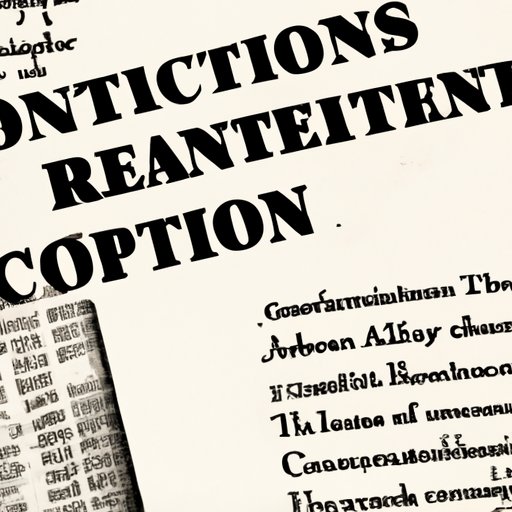Introduction
The Articles of Confederation, the first governing document of the United States, were created in 1777 amid the Revolutionary War. The Articles were designed to establish a loose confederation of states which could cooperate for purposes like mutual defense while still retaining a significant degree of sovereignty.
While the Articles served as a crucial starting point for the development of the U.S., they were ultimately unsuccessful in providing a functional and effective national government, leading to the development and ratification of the U.S. Constitution in 1787. In this article, we will examine the key reasons why the Articles failed and why they were ultimately replaced.
Historical Context
When the Articles of Confederation were being created, the United States was a newly-formed country, still fighting for independence from Great Britain. But even beyond the war effort, the economic and political climate of the country was vastly different from what it is today.
Many of the colonists who later became U.S. citizens were wary of a central government having too much power, having just broken free from what they saw as an oppressive monarchy in Britain. They wanted to ensure that each state in the new country had a significant degree of autonomy, which led to the creation of the Articles.
Comparison with the Constitution
One of the primary reasons that the Articles of Confederation failed was that they provided a very weak central government, in sharp contrast to the current U.S. Constitution. While the Constitution creates three branches of government (executive, legislative, and judicial), the Articles established only one branch, Congress.
Additionally, the Constitution establishes the federal government as sovereign over the states, while the Articles affirmed the sovereignty of the individual states and gave the central government very limited power. These differences between the two documents made it much harder for the government to enforce laws and to make meaningful decisions.
Limitations of Central Power
The Articles established a government with extremely limited powers. Congress, as mentioned, was the only branch of government, and it had very strict limitations on what it could do. For example, Congress could make decisions on foreign affairs, but it could not raise an army or levy taxes.
This lack of central power was in many ways the Achilles heel of the Articles. It meant that in many respects, the government was insufficiently equipped to handle the challenges of managing a country. The weaknesses of the central government meant that states acted independently, often prioritizing their own interests rather than those of the country as a whole.
Issues with Interstate Relations
The Articles of Confederation also failed to offer clear guidance on how to handle problems that involved multiple states. One of the most significant of these issues was interstate commerce, as the Articles made it difficult for the government to establish and enforce laws regarding trade or taxes.
As a result, states often engaged in economic protectionism and commercial rivalries, leading to increased discord within the country and a loss of economic stability. Additionally, the states were often at odds over issues of boundaries, territorial interests, and even the fundamental nature of the national government.
Lack of Executive Branch
The Articles of Confederation failed to establish an executive branch with a single, centralized executive leader. While Congress served as the central governing authority, it lacked the ability to execute its own decisions. This was due in part to the way that voting worked in Congress. Each state only had one vote, making it difficult to reach a consensus on important issues.
The lack of an executive branch meant that there was no one person or group responsible for enforcing laws, implementing decisions, or providing direction in times of crisis. This left the government vulnerable and ineffective in times of war or uncertainty.
Failure to Collect Taxes
Perhaps the most significant limitation on the central government established by the Articles was its inability to levy taxes. Instead, the government had to request money from the states, which led to a lack of funding. This meant that the central government was often unable to pay off debts or fund projects that it deemed necessary for the functioning of the country.
Furthermore, some states refused to contribute to the national government, which only exacerbated the financial issues the country was facing. This failure to collect taxes and establish consistent funding made it almost impossible for the government to operate effectively.
Conclusion
The weaknesses of the Articles of Confederation hampered the early development of the United States. The limitations on central power, inadequate regulation of interstate commerce, lack of an executive branch, and inability to collect taxes all contributed to a national government that simply was not equipped to handle the challenges it faced.
The development and ratification of the U.S. Constitution ultimately resolved many of these issues, but the legacy of the Articles of Confederation lives on as a cautionary tale about the dangers of weak central government.
As citizens of the United States, it is important that we continue to engage with issues related to the structure and effectiveness of our government. By doing so, we can help ensure that our country remains strong and prosperous for generations to come.
